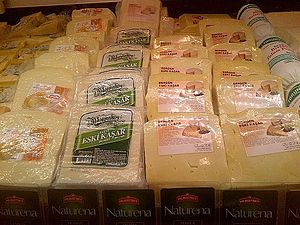Kaşar

Kaşar (“Kaschar”) is a Turkish semi-hard cheese that was originally made mainly from sheep's milk or goat's milk . Today, however, more and more people are making Kaşar cheese from cow's milk . Nowadays it is produced almost exclusively industrially from treated, pasteurized milk and not from raw milk .
The most famous and also one of the most expensive varieties is the so-called Kars -Kaşar from the northeastern province of the same name in Turkey.
Kaşar is closely related to the Kasseri , which comes from Greece, and the Kashkawal from Bulgaria. Assyrians use the cheese to make the traditional Assyrian cheese dish Gupta Tomirta ( Aramaic ܓܘܒܬܐ ܜܘܡܪܬܐ, literally “buried cheese”) - which is seasoned with cumin, among other things.
This cheese is eaten on bread (for breakfast), placed on toast or can also be used in (toast) sandwiches. Kaşar can also be baked well, as it melts relatively well, depending on the variety.
Nowadays practically every hard or semi-hard cheese is colloquially called simply "Kaşar" in Turkey.
Appearance / taste
Kaşar is light to white in color; the consistency is smooth to firm. The Kars variety , on the other hand, is a little firmer and slightly darker in color due to the longer storage or maturation. The variety of flavors ranges from mild to slightly spicy, with Kars again being a little more piquant.
The aroma can best be compared with a mild provolone or in terms of taste with a mild Gouda or Havarti . The holes in the cheese do not necessarily play a role in kasar; they do not represent a quality feature; holes that are too large are undesirable.
history
Kaşar peyniri ("Kaşar cheese") is mentioned for the first time around 1900 in the then Ottoman Empire . From a cultural and historical point of view, this is relatively late, considering the first mentions of European cheeses. As the name of the most expensive variety suggests, this type of production in Turkey comes for the first time from the province of Kars and was very likely adopted by Russia. This area was fought over for several years between the Ottomans and Russians towards the end of the 18th century, and there are other cultural exchanges from this period. During the period of Russian rule over the Kars area, there were a.o. a. German and Swiss colonists settled here, not least because they were viewed as specialists in milk processing. This type of cheese-making was the Turks previously not known, they knew by then only the brine cheese or much older recipe originally Central Asian Yörük of the so-called Çökelek , a kind of sour milk cheese .